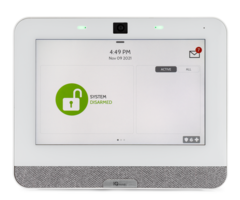What Kind Of Wire Do I Need For A Qolsys IQ Panel 4 Installation?
The Qolsys IQ Panel 4, out of the box, is an all-in-one wireless system. If you plan to use it with wireless sensors, then the only wire you'll need is for power. The panel comes with a ten (10) foot pre-made power wire with a barrel connector at one end, and spade connectors at the other.


The pre-made power wire comes with the spade connectors already connected to the DC power adapter. Since this is a DC adapter, polarity is important, so check to be sure that the lead marked with a red spade connector is on the positive (+) screw terminal and the lead marked with a black spade connector is on the negative (-) terminal of the power adapter. The barrel connector will connect to the female barrel port on the back of the IQ Panel 4.
If the provided power wire isn't long enough, you can make your own power cable using a custom length of wire. Per the specifications found in the installation guide, you can use a 2-conductor wire that is from 18AWG to 22AWG in size. AWG stands for American Wire Gauge, and the larger the AWG number, the smaller the circumference of the wire. When 18AWG wire is used, the wire length can be up to 98.5 Feet (30m) from the power adapter to the panel.
When it comes to power wiring, particularly when a DC power adapter is used, the heavier the wire gauge, the better. Never exceed the recommended wire length based on the wire gauge, as this will eventually cause problems, such as the system battery not charging properly. The specifications provided by Qolsys don't mention how long the wire run can be if you use 22AWG or 20AWG, so our recommendation is, if your power wire must be longer than the 10-foot cable provided, just use 18AWG wire.
Although the Qolsys IQ Panel 4 is a wireless system, it can support wired zones. There are a couple of options for doing this. Qolsys offers the IQ Hardwire 16-F which can be used to convert existing wired zones to 319.5 MHz wireless with S-Line encryption capability. This module is meant to be installed inside an existing alarm panel's metal cabinet, basically replacing that panel. There is also an IQ Hardwire 16-F Large Enclosure. It comes with one (1) Hardwire 16-F in a plastic enclosure that can house up to two (2) Hardwire 16-F modules, each with its own backup battery. This version of the Hardwire 16-F is meant to replace the previous panel's metal enclosure.

Either of these modules is perfect for situations where you will be replacing an older panel with wired zones. You get all the modern features associated with the new all-in-one Qolsys IQ Panel 4, with the reliability of wired sensors. Plus, you don't have to replace all of the wired sensors you're accustomed to using, and that are still working. If you have a wired sensor that isn't working, simply replace it with a wireless one. The Hardwire 16-F can support up to 16 zones, with Zone 16 supporting up to ten (10) compatible 2-wire smoke detectors. The Hardwire 16-F also provides power for powered wired devices such as motion detectors and glass break detectors. To top it off, the module has the ability to support the addition of a wired siren, either directly, or using a relay and a power supply, depending on the operating current requirements of the siren or sirens in question.
If you need wired-to-wireless conversion, but you're not using a version of the Qolsys IQ Panel 4 that supports 319.5 MHz sensors, or you need a module that can transmit over much greater distance, the IQ Panel 4 also supports the DSC PowerG converter module (PG9WLSHW8). Each of these modules can support up to eight (8) wired zones, offers up to four (4) programmable outputs, either 2-wire or 4-wire smoke detectors, and a wired siren output of up to 700mA. This module also offers the unique ability to support some DSC wired keypads using DSC's Corbus technology. There is also a large enclosure version of this converter module.

So, getting back to the original question, if you plan to use wired zones with the Qolsys IQ Panel 4, you'll most likely be using existing wired sensors and a wired-to-wireless converter module. In this case, the only wire you'll be adding in this scenario is the power wire for the converter module itself. The IQ Hardwire 16-F comes with a pre-made cable, much like the panel itself. There are no specifications in the documentation about using wiring other than that provided by the factory, so we recommend only using that wire. The DSC PG9WLSHW8, which does not come with a power wire, recommends the following wiring gauge and distance limits for that module:
| Distance Feet/Meters | Wire Gauge |
|---|---|
| 6.5/2 | 22 |
| 10/3 | 20 |
| 13/4 | 18 |
As a general rule, we recommend using stranded wire, as opposed to solid copper, because it's easier to work with, is less prone to breakage, and offers a greater acceptable bend radius.
Did you find this answer useful?
We offer alarm monitoring as low as $10 / month
Click Here to Learn MoreRelated Products









Related Categories
- Apartment Security Systems
- Home Automation Controllers
- Smart Home Controllers
- Small Business Security Systems
- Touchscreen Alarm Panels
- DIY Wireless Security Systems
- Monitored Home Security Systems
- Touchscreen Alarm Panels
- DIY Wired Security Systems
- Wired to Wireless Security System Converters
- Answered
- Answered By
- Julia Ross

